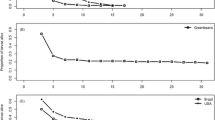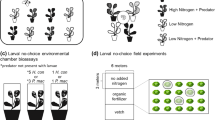Abstract
Insect herbivores exhibit various strategies to counter the toxic effects of plant chemical defenses. These strategies include the detoxification, excretion, and sequestration of plant secondary metabolites. The latter strategy is often considered to provide an additional benefit in that it provides herbivores with protection against natural enemies such as predators. Profiles of sequestered chemicals are influenced by the food plants from which these chemicals are derived. We compared the effects of sequestration and nonsequestration of plant secondary metabolites in two specialist herbivores on the development of a generalist predator, Podisus maculiventris. Profiles of glucosinolates, secondary metabolites characteristic for the Brassicaceae, are known to differ considerably both inter- and intraspecifically. Throughout their immature (=nymphal) development, the predator was fed on larval stages of either sequestering (turnip sawfly, Athalia rosae) or nonsequestering (small cabbage white butterfly, Pieris rapae) prey that in turn had been feeding on plants originating from three wild cabbage (Brassica oleracea) populations that have previously been shown to differ in their glucosinolate profiles. We compared survival, development time, and adult body mass as parameters for bug performance. Our results show that sequestration of glucosinolates by A. rosae only marginally affected the development of P. maculiventris. The effects of plant population on predator performance were variable. We suggest that sequestration of glucosinolates by A. rosae functions not only as a defensive mechanism against some predators, but may also be an alternative way of harmlessly dealing with plant allelochemicals.



Similar content being viewed by others
References
Abdalsamee MK, Müller C (2012) Effects of indole glucosinolates on performance and sequestration by the sawfly Athalia rosae and consequences of feeding on the plant defence system. J Chem Ecol 38:1366–1375
Agrawal AA, Petschenka G, Bingham RA, Weber MG, Rasmann S (2012) Toxic cardenolides: chemical ecology and coevolution of specialized plant-herbivore interactions. New Phytol 194:28–45
Biere A, Marak HB, van Damme JMM (2004) Plant chemical defence against herbivores and pathogens: generalized defence or trade-offs? Oecologia 140:430–441
Boevé J-L, Müller C (2005) Defence effectiveness of easy bleeding sawfly larvae towards invertebrate and avian predators. Chemoecology 15:51–58
Boevé J-L, Schaffner U (2003) Why does the larval integument of some sawfly species disrupt so easily? The harmful hemolymph hypothesis. Oecologia 134:104–111
Coley PD, Bateman ML, Kursar TA (2006) The effect of plant quality on caterpillar growth and defense against natural enemies. Oikos 115:219–228
De Clercq P, Degheele D (1994) Laboratory measurement of predation by Podisus maculiventris and P. sagittal (Hemiptera: Pentatomidae) on beet armyworm (Lepidoptera: Noctuidae). J Econ Entomol 87:76–87
De Clercq P, Merlevede F, Metsdagh I, Vandendurpel K, Mohaghegh J, Degheele D (1998) Predation on the tomato looper Chrysodeixis chalcites (Esper) (Lep., Noctuidae) by Podisus maculiventris (Say) and Podisus nigrispinus (Dallas) (Het., Pentatomidae). J Appl Entomol 122:92–98
Ehrlich PR, Raven PH (1964) Butterflies and plants—a study in coevolution. Evolution 18:586–608
Fordyce JA (2001) The lethal plant defence paradox remains: inducible host-plant aristolochic acids and the growth and defence of the pipevine swallowtail. Entomol Exp Appl 100:339–346
Giamoustaris A, Mithen R (1995) The effect of modifying the glucosinolates content of leaves of oilseed rape (Brassica napus spp. oleifera) on its interaction with specialist and generalist pests. Ann Appl Biol 126:347–363
Gols R, Harvey JA (2009) Plant-mediated effects in the Brassicaceae on the performance and behaviour of parasitoids. Phytochem Rev 8:187–206
Gols R, Bukovinszky T, van Dam NM, Dicke M, Bullock JM, Harvey JA (2008a) Performance of generalist and specialist herbivores and their endoparasitoids differs on cultivated and wild Brassica populations. J Chem Ecol 34:132–143
Gols R, Wagenaar R, Bukovinszky T, van Dam NM, Dicke M, Bullock JM, Harvey JA (2008b) Genetic variation in defense chemistry in wild cabbage affect herbivores and their endoparasitoids. Ecology 89:1616–1626
Hartmann T, Theuring C, Beuerle T, Ernst L, Singer MS, Bernays EA (2004) Acquired and partially de novo synthesized pyrrolizidine alkaloids in two polyphagous arctiids and the alkaloid profiles of their larval food-plants. J Chem Ecol 30:229–254
Harvey JA, Gols R (2011) Population-related variation in plant defense more strongly affects survival of an herbivore than its solitary wasp. J Chem Ecol 37:1081–1090
Harvey JA, van Dam NM, Gols R (2003) Interactions over four trophic levels: food plant quality affects development of a hyperparasitoid as mediated through a herbivore and its primary parasitoid. J Chem Ecol 72:520–531
Harvey JA, van Nouhuys S, Biere A (2005) Effects of qualitative variation in allelochemicals in Plantago lanceolata on development of a generalist and a specialist herbivore and their endoparasitoids. J Chem Ecol 31:287–302
Harvey JA, Gols R, Wagenaar R, Bezemer TM (2007) Development of an insect herbivore and its pupal parasitoid reflect differences in direct plant defense. J Chem Ecol 33:1556–1569
Harvey JA, van Dam NM, Raaijmakers CE, Bullock JM, Gols R (2011) Tri-trophic effects of inter- and intra-population variation in defence chemistry of wild cabbage (Brassica oleracea). Oecologia 166:421–431
Holzinger F, Frick C, Wink M (1992) Molecular basis of the insensitivity of the Monarch (Danaus plexippus) to cardiac glycosides. FEBS Lett 314:477–480
Hopkins RJ, van Dam NM, van Loon JA (2009) Role of glucosinolates in plant-insect relationships and multitrophic interactions. Annu Rev Entomol 54:57–83
Jaenike J (1990) Host specialization in phytophagous insects. Annu Rev Ecol Syst 21:243–273
Jones AME, Bridges M, Bones AM, Cole R, Rossiter JT (2001) Purification and characterization of a non-plant myrosinase from the cabbage aphid Brevicoryne brassicae (L.). Insect Biochem Mol 31:1–5
Lampert EC, Dyer LA, Bowers MD (2011) Chemical defence across three trophic levels: Catalpa bignonioides, the caterpillar Ceratomia catalpae, and its endoparasitoid Cotesia congregata. J Chem Ecol 37:1063–1070
Loxdale HD, Lushai G, Harvey JA (2011) The evolutionary improbability of ‘generalism’ in nature, with special reference to insects. Biol J Linn Soc 103:1–18
Macel M, Bruinsma M, Dijkstra SM, Ooijendijk T, Niemeyer HM, Klinkhamer PGL (2005) Differences in effects of pyrrolizidine alkaloids on five different generalist insect herbivore species. J Chem Ecol 31:1493–1508
Malcolm SB, Brower LP (1989) Evolutionary and ecological implications of cardenolide sequestration in the monarch butterfly. Experientia 45:284–295
Merritt SZ (1996) Within-plant variation in concentrations of amino acids, sugar, and sinigrin in phloem sap of black mustard, Brassica nigra (L.) Koch (Cruciferae). J Chem Ecol 22:1133–1145
Mitter C, Farrell B, Futuyma DJ (1991) Phylogenetic studies of insect plant interactions—insights into the genesis of diversity. TREE 6:290–293
Moyes CL, Collin HA, Britton G, Raybould AF (2000) Glucosinolates and differential herbivory in wild populations of Brassica oleracea. J Chem Ecol 26:2625–2641
Müller C (2009) Interactions between glucosinolate- and myrosinase-containing plants and the sawfly Athalia rosae. Phytochem Rev 8:121–134
Müller C, Arand K (2007) Trade-offs in oviposition choice? Food dependent performance and defence against predators of a herbivorous sawfly. Entomol Exp Appl 124:153–159
Müller C, Brakefield PM (2003) Analysis of a chemical defense in sawfly larvae: easy bleeding targets predatory wasps in late summer. J Chem Ecol 29:2683–2694
Müller C, Wittstock U (2005) Uptake and turn-over of glucosinolates sequestered in the sawfly Athalia rosae. Insect Biochem Mol 35:1189–1198
Müller C, Agerbrink N, Olsen CE, Boevé J-L, Schaffner U, Brakefield PM (2001) Sequestration of host plant glucosinolates in the defensive hemolymph of the sawfly Athalia rosae. J Chem Ecol 27:2505–2516
Müller C, Boeve J-L, Brakefield PM (2002) Host plant derived feeding deterrence towards ants in the turnip sawfly Athalia rosae. Entomol Exp Appl 104:153–157
Müller C, Agerbrink N, Olsen CE (2003) Lack of sequestration of host plant glucosinolates in Pieris rapae and P. brassicae. Chemoecology 13:47–54
Nishida R (2002) Sequestration of defensive substances from plants by Lepidoptera. Annu Rev Entomol 47:57–92
O’Neil RJ (1988) Predation by Podisus maculiventris (Say) on Mexican bean beetle, Epilachna varivestis Mulsant, in Indians soybeans. Can Entomol 120:161–166
Ode PJ (2006) Plant chemistry and natural enemy fitness: effects on herbivore and natural enemy interactions. Annu Rev Entomol 51:163–185
Opitz SEW, Müller C (2009) Plant chemistry and insect sequestration. Chemoecology 19:117–154
Opitz SEW, Jensen SR, Müller C (2010) Sequestration of glucosinolates and iridoid glucosides in sawfly species of the genus Athalia and their role in defence against ants. J Chem Ecol 36:148–157
Price PW (1972) Parasitoids utilizing the same host: adaptive nature of differences in size and form. Ecology 53:190–195
Renwick JAA (2002) The chemical world of crucivores: lures, treats and traps. Entomol Exp Appl 104:35–42
Reudler JH, Biere A, Harvey JA, van Nouhuys S (2011) Differential performance of a specialist and two generalist herbivores and their endoparasitoids on Plantago lanceolata. J Chem Ecol 37:765–778
Shorey HH, Hale RL (1965) Mass-rearing of larvae of 9 noctuid species on a simple artificial medium. J Econ Entomol 58:522–524
Singer MS, Bernays EA (2009) Specialized generalists: Evolutionary ecology of polyphagous woolly bear caterpillars. In: Conner WE (ed) Tiger moths and woolly bears: behavior, ecology, and evolution of the Arctiidae. Oxford University Press, Oxford, pp 103–114
Soler R, van der Putten WH, Harvey JA, Vet LEM, Dicke M, Bezemer TM (2012) Root herbivore effects on aboveground multitrophic interactions: patterns, processes and mechanisms. J Chem Ecol 38:755–767
Starý P (1970) Biology of aphid parasites (Hymenoptera: Aphindiidae) with respect to biological control. Series Entomologica 6. Dr. W. Junk, The Hague
Trigo JR (2000) The chemistry of antipredator defense by secondary compounds in neotropical Lepidoptera: facts, perspectives and caveats. J Brazil Chem Soc 11:551–561
van Dam NM, Hadwich K, Baldwin IT (2005) Induced responses in Nicotiana attenuata affect behavior and growth of the specialist herbivore Manduca sexta. Oecologia 122:371–379
van Geem M, Gols R, van Dam NM, van der Putten WH, Fortuna T, Harvey JA (2013) The importance of aboveground-belowground interactions on the evolution and maintenance of variation in plant defense traits. Front Plant Sci 4:431
Vlieger L, Brakefield PM, Müller C (2004) Effectiveness of the defence mechanism of the turnip sawfly, Athalia rosae (Hymenoptera: Tenthredinidae), against predation by lizards. Bull Entomol Res 94:283–289
Vrieling K, Soldaat LL, Smit W (1991) The influence of pyrrolizidine alkaloids of Senecio jacobea on Tyria jacobaeae, Brachycaudus cardii and Haplothrips senecionis. Neth J Zool 41:228–239
Weiser LA, Stamp NE (1998) Combined effects of allelochemicals, prey availability, and supplemental plant material on growth of a generalist insect predator. Entomol Exp Appl 87:181–189
Winde I, Wittstock U (2011) Insect herbivore counteradaptations to the plant glucosinolate-myrosinase system. Phytochemistry 72:1566–1575
Wittstock U, Agerbirk N, Stauber EJ, Olsen CE, Hippler M, Mitchell-Olds T, Gershenson J, Vogel H (2004) Successful herbivore attack due to metabolic diversion of a plant chemical defense. Proc Natl Acad Sci 101:4859–4864
Zangerl AR, Berenbaum MR (2003) Phenotype matching in wild parsnip and parsnip webworms: causes and consequences. Evolution 57:806–815
Zangerl AR, Berenbaum MR (2005) Increase in toxicity of an invasive weed after reassociation with its coevolved herbivore. Proc Natl Acad Sci U S A 102:15529–15532
Acknowledgments
The authors thank Caroline Müller for providing them with A. rosae pupae. Jeffrey A. Harvey and Moniek van Geem were financially supported by a grant (No. 821006) from the Earth and Life Sciences Foundation (ALW), which is subsidized by the Netherlands Organization for Scientific Research (NWO). This is publication number 5633 of the Netherlands Institute of Ecology (NIOO-KNAW).
Author information
Authors and Affiliations
Corresponding author
Additional information
Communicated by: Sven Thatje
Rights and permissions
About this article
Cite this article
van Geem, M., Harvey, J.A. & Gols, R. Development of a generalist predator, Podisus maculiventris, on glucosinolate sequestering and nonsequestering prey. Naturwissenschaften 101, 707–714 (2014). https://doi.org/10.1007/s00114-014-1207-x
Received:
Revised:
Accepted:
Published:
Issue Date:
DOI: https://doi.org/10.1007/s00114-014-1207-x




